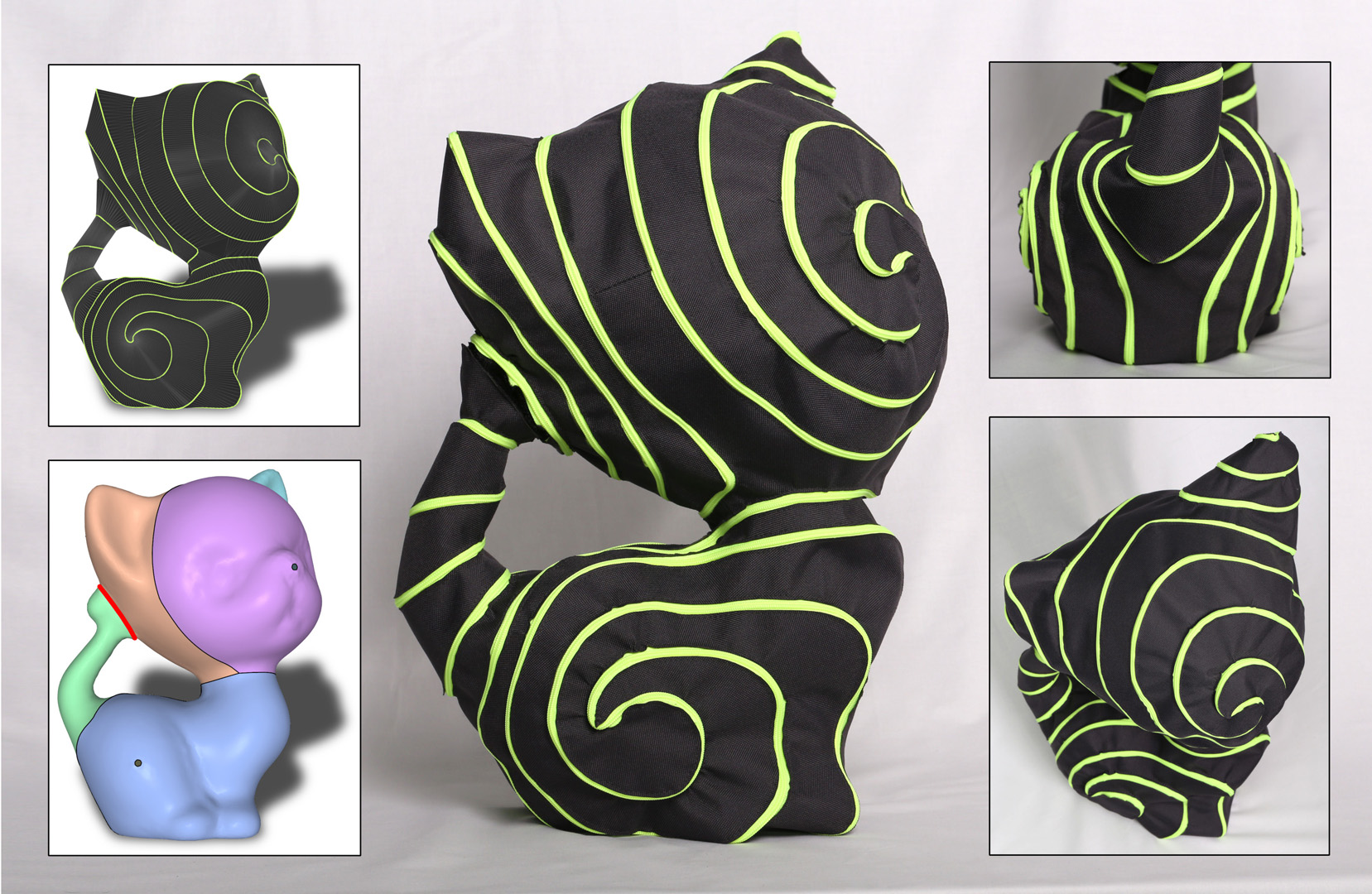“Shape representation by zippables” by Schüller, Poranne and Sorkine-Hornung
Conference:
Type(s):
Entry Number: 78
Title:
- Shape representation by zippables
Session/Category Title: Cutting, Zipping and Folding Surfaces
Presenter(s)/Author(s):
Moderator(s):
Abstract:
Fabrication from developable parts is the basis for arts such as papercraft and needlework, as well as modern architecture and CAD in general, and it has inspired much research. We observe that the assembly of complex 3D shapes created by existing methods often requires first fabricating many small parts and then carefully following instructions to assemble them together. Despite its significance, this error prone and tedious process is generally neglected in the discussion. We present the concept of zippables – single, two dimensional, branching, ribbon-like pieces of fabric that can be quickly zipped up without any instructions to form 3D objects. Our inspiration comes from the so-called zipit bags [zipit 2017], which are made of a single, long ribbon with a zipper around its boundary. In order to “assemble” the bag, one simply needs to zip up the ribbon. Our method operates in the same fashion, but it can be used to approximate a wide variety of shapes. Given a 3D model, our algorithm produces plans for a single 2D shape that can be laser cut in few parts from fabric or paper. A zipper can then be attached along the boundary by sewing, or by gluing using a custom-built fastening rig. We show physical and virtual results that demonstrate the capabilities of our method and the ease with which shapes can be assembled.
References:
1. N. Aigerman and Y. Lipman. 2015. Orbifold Tutte Embeddings. ACM Trans. Graph. 34, 6, Article 190 (Oct. 2015), 12 pages. Google ScholarDigital Library
2. D. Barnette and E. Jucovič. 1970. Hamiltonian circuits on 3-polytopes. Journal of Combinatorial Theory 9, 1 (1970), 54 — 59.Google ScholarCross Ref
3. B. Bickel, M. Bächer, M. A. Otaduy, H. R. Lee, H. Pfister, M. Gross, and W. Matusik. 2010. Design and Fabrication of Materials with Desired Deformation Behavior. ACM Trans. Graph. 29, 4, Article 63 (July 2010), 10 pages. https://d0i.0rg/10.1145/1778765.1778800 Google ScholarDigital Library
4. D. Bommes, B. Lévy, N. Pietroni, E. Puppo, C. Silva, M. Tarini, and D. Zorin. 2013. Quad-Mesh Generation and Processing: A Survey. Comput. Graph. Forum 32, 6 (2013), 51–76. Google ScholarDigital Library
5. S. Chandra, A. Körner, A. Koronaki, R. Spiteri, R. Amin, S. Kowli, and M. Weinstock. 2015. Computing curved-folded tessellations through straight-folding approximation. In Proc. Symposium on Simulation for Architecture & Urban Design, http://dl.acm.org/citation.cfm?id=2873042 Google ScholarDigital Library
6. X. Chen, C. Zheng, W. Xu, and K. Zhou. 2014. An Asymptotic Numerical Method for Inverse Elastic Shape Design. ACM Trans. Graph. 33, 4 (2014). Google ScholarDigital Library
7. D. Eppstein and M. Gopi. 2004. Single-strip triangulation of manifolds with arbitrary topology. In Proc. Symp. Computational Geometry. 455–456. Google ScholarDigital Library
8. A. Fondevilla, A. Bousseau, D. Rohmer, S. Hahmann, and M. Cani. 2017. Patterns from photograph: Reverse-engineering developable products. Computers & Graphics 66 (2017), 4–13.Google ScholarCross Ref
9. K. Hormann, B. Lévy, and A. Sheffer. 2007. Mesh parameterization: theory and practice. In ACM SIGGRAPH Courses. Google ScholarDigital Library
10. Y. Igarashi and T. Igarashi. 2008. Pillow: Interactive Flattening of a 3D Model for Plush Toy Design. In Proc. Smart Graphics. Google ScholarDigital Library
11. Y. Igarashi, T. Igarashi, and H. Suzuki. 2009. Interactive Cover Design Considering Physical Constraints. Comput. Graph. Forum 28, 7 (2009), 1965–1973.Google ScholarCross Ref
12. D. Julius, V. Kraevoy, and A. Sheffer. 2005. D-Charts: Quasi-Developable Mesh Segmentation. Comput. Graph. Forum 24, 3 (2005), 581–590.Google ScholarCross Ref
13. A.Jung, S. Hahmann, D. Rohmer, A. Begault, L. Boissieux, and M. Cani. 2015. Sketching Folds: Developable Surfaces from Non-Planar Silhouettes. ACM Trans. Graph. 34, 5 (2015), 155:1–155:12. Google ScholarDigital Library
14. F. Kälberer, M. Nieser, and K. Polthier. 2011. Stripe parameterization of tubular surfaces. In Topological Methods in Data Analysis and Visualization. Springer, 13–26.Google Scholar
15. M. Kilian, S. Flöry, Z. Chen, N. J. Mitra, A. Sheffer, and H. Pottmann. 2008. Curved folding. ACM Trans. Graph. 27, 3 (2008). Google ScholarDigital Library
16. F. Knöppel, K. Crane, U. Pinkall, and P. Schröder. 2015. Stripe patterns on surfaces. ACM Trans. Graph. 34, 4 (2015). Google ScholarDigital Library
17. S. Kolmianič and N. Guid. 2002. From Geometric Modeling to Shape Modeling. In Proc. Workshop on Geometric Modeling: Fundamentals and Applications. 35–46. http://dl.acm.org/citation.cfm?id=512296.512302Google Scholar
18. S. Z. Kovalsky, M. Galun, and Y. Lipman. 2016. Accelerated quadratic proxy for geometric optimization. ACM Trans. Graph. 35, 4 (2016), 134. Google ScholarDigital Library
19. Y. Liu, Y. Lai, and S. M. Hu. 2009. Stripification of Free-Form Surfaces With Global Error Bounds for Developable Approximation. IEEE Trans. Automation Science and Engineering 6, 4 (2009), 700–709.Google ScholarCross Ref
20. M. Livesu, M. Attene, G. Patanè, and M. Spagnuolo. 2017. Explicit cylindrical maps for general tubular shapes. Computer-Aided Design (2017). Accepted for publication.Google Scholar
21. A. Lubiw, E. D. Demaine, M. L. Demaine, A. Shallit, and J. Shallit. 2010. Zipper unfoldings of polyhedral complexes. In Proceedings of the 22nd Annual Canadian Conference on Computational Geometry, Winnipeg, Manitoba, Canada, August 9–11, 2010. 219–222. http://cccg.ca/proceedings/2010/paper58.pdfGoogle Scholar
22. A. Mahdavi-Amiri, P. Whittingham, and F. Samavati. 2015. Cover-it: an interactive system for covering 3D prints. In Proc. Graphics Interface. 73–80. Google ScholarDigital Library
23. T. Martin, E. Cohen, and M. Kirby. 2008. Volumetric parameterization and trivariate b-spline fitting using harmonic functions. In Proceedings of the 2008 ACM Symposium on Solid and Physical Modeling, Stony Brook, New York, USA, June 2–4, 2008. 269–280. Google ScholarDigital Library
24. F. Massarwi, C. Gotsman, and G. Elber. 2007. Papercraft Models using Generalized Cylinders. In Proc. Pacific Graphics. Google ScholarDigital Library
25. J. Mitani and H. Suzuki. 2004. Making papercraft toys from meshes using strip-based approximate unfolding. ACM Trans. Graph. 23, 3 (2004), 259–263. Google ScholarDigital Library
26. Y. Mori and T. Igarashi. 2007. Plushie: an interactive design system for plush toys. ACM Trans. Graph. 26, 3 (2007). Google ScholarDigital Library
27. A. Myles and D. Zorin. 2012. Global parametrization by incremental flattening. ACM Trans. Graph. 31, 4 (2012), 109:1–109:11. Google ScholarDigital Library
28. J. O’Rourke. 2015. Spiral Unfoldings of Convex Polyhedra. arXiv preprint arXiv:1509.00321 (2015).Google Scholar
29. H. Pedersen. 2011. Methods for Creating Developable Surfaces. (July 14 2011). https://www.google.ch/patents/US20110169828 US Patent App. 13/005,384.Google Scholar
30. H. Pedersen and K. Singh. 2006. Organic Labyrinths and Mazes. In Proceedings of the 4th International Symposium on Non-photorealistic Animation and Rendering (NPAR ’06). ACM, New York, NY, USA, 79–86. Google ScholarDigital Library
31. M. Rabinovich, R. Poranne, D. Panozzo, and O. Sorkine-Hornung. 2017. Scalable Locally Injective Mappings. ACM Trans. Graph. 36, 2 (2017), 16:1–16:16. Google ScholarDigital Library
32. N. Ray, W. Li, B. Lévy, A. Sheffer, and P. Alliez. 2006. Periodic global parameterization. ACM Trans. Graph. 25, 4 (2006). Google ScholarDigital Library
33. K. Rose, A. Sheffer, J. Wither, M.-P. Cani, and B. Thibert. 2007. Developable Surfaces from Arbitrary Sketched Boundaries. In Proc. Symp. Geom. Processing. 163–172. Google ScholarDigital Library
34. J. Rossignac. 1999. Edgebreaker: Connectivity Compression for Triangle Meshes. IEEE Trans. Vis. Comput. Graph. 5, 1 (1999), 47–61. Google ScholarDigital Library
35. I. Shatz, A. Tal, and G. Leifman. 2006. Paper craft models from meshes. The Visual Computer 22, 9–11 (2006), 825–834. Google ScholarDigital Library
36. J. R. Shewchuk. 1996. Triangle: Engineering a 2D Quality Mesh Generator and Delaunay Triangulator. In Applied Computational Geometry: Towards Geometric Engineering. Lecture Notes in Computer Science, Vol. 1148. 203–222. Google ScholarDigital Library
37. A. Shtengel, R. Poranne, O. Sorkine-Hornung, S. Z. Kovalsky, and Y. Lipman. 2017. Geometric Optimization via Composite Majorization. ACM Trans. Graph. 36, 4, Article 38 (July 2017), 11 pages. Google ScholarDigital Library
38. M. Skouras, B. Thomaszewski, B. Bickel, and M. H. Gross. 2012. Computational Design of Rubber Balloons. Comput. Graph. Forum 31, 2 (2012), 835–844. Google ScholarDigital Library
39. M. Skouras, B. Thomaszewski, S. Coros, B. Bickel, and M. Gross. 2013. Computational design of actuated deformable characters. ACM Trans. Graph. 32, 4 (2013), 82:1–82:10. Google ScholarDigital Library
40. M. Skouras, B. Thomaszewski, P. Kaufmann, A. Garg, B. Bickel, E. Grinspun, and M. H. Gross. 2014. Designing inflatable structures. ACM Trans. Graph. 33, 4 (2014). Google ScholarDigital Library
41. J. Smith and S. Schaefer. 2015. Bijective Parameterization with Free Boundaries. ACM Trans. Graph. 34, 4, Article 70 (2015), 9 pages. Google ScholarDigital Library
42. R. Straub and H. Prautzsch. 2011. Creating optimized cut-out sheets for paper models from meshes. Technical Report. Karlsruhe Institute of Technology.Google Scholar
43. S. Takahashi, H. Wu, S. H. Saw, C. Lin, and H. Yen. 2011. Optimized Topological Surgery for Unfolding 3D Meshes. Comput. Graph. Forum 30, 7 (2011), 2077–2086.Google ScholarCross Ref
44. C. Tang, P. Bo, J. Wallner, and H. Pottmann. 2016. Interactive Design of Developable Surfaces. ACM Trans. Graph. 35, 2, Article 12 (2016), 12 pages. Google ScholarDigital Library
45. M. Tarini. 2012. Cylindrical and Toroidal Parameterizations Without Vertex Seams. J. Graphics Tools 16, 3 (2012), 144–150.Google ScholarCross Ref
46. J. Thiery, B. Buchholz, J. Tierny, and T. Boubekeur. 2012. Analytic Curve Skeletons for 3D Surface Modeling and Processing. Comput. Graph. Forum 31, 7–2 (2012), 2223–2232. Google ScholarDigital Library
47. C. C. L. Wang. 2010. From Designing Products to Fabricating Them from Planar Materials. IEEE Computer Graphics and Applications 30, 6 (2010), 74–85. Google ScholarDigital Library
48. L. Zeng, Y. Liu, M. Chen, and M. M. Yuen. 2012. Least squares quasi-developable mesh approximation. Computer Aided Geometric Design 29, 7 (2012), 565–578. Google ScholarDigital Library
49. H. Zhao, F. Gu, Q. Huang, J. A. G. Galicia, Y. Chen, C. Tu, B. Benes, H. Zhang, D. Cohen-Or, and B. Chen. 2016. Connected Fermat spirals for layered fabrication. ACM Trans. Graph. 35, 4 (2016), 100:1–100:10. Google ScholarDigital Library
50. Y. Zhou, K. Yin, H. Huang, H. Zhang, M. Gong, and D. Cohen-Or. 2015. Generalized Cylinder Decomposition. ACM Trans. Graph. 34, 6 (2015), Article 171. Google ScholarDigital Library
51. zipit. 2017. zip it store online, http://www.zipitstore.com/. (2017). Accessed: 2017-02-01.Google Scholar




